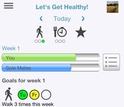
Research News
Researchers from CMU and PARC use predictive analytics and artificial intelligence to develop tailored health interventions for personalized wellness
July 24, 2015
July is Parks and Recreation Month, encouraging Americans to embrace natural spaces and promote health and wellness.
Adults frequently report that they enjoy the outdoors, including recreational sports, walking in nature and spending time outside with loved ones. But surveys from the National Recreation and Park Association (NRPA) indicate that 30 percent of adults spend minimal time outdoors–and those who do venture outside daily typically spend less than 30 minutes being active. Computer science and predictive models can offer tools to support desired behaviors and better foster this connection.
Personalizing health and fitness is profoundly important as one’s fitness levels, wellness goals and access to resources can be highly variable. Gym environments, for example, do not represent universally enjoyable exercise and not all individuals have access to gyms. National parks and recreation facilities, coupled with personalized mobile tools expand the opportunities for Americans to engage in sustainable, healthy practices.
With support from the National Science Foundation’s (NSF) Smart and Connected Health program, researchers Bob Kraut and Mengshoel Ole from Carnegie Mellon University (CMU) and Michael Youngblood and Peter Pirolli of the Palo Alto Research Center (PARC) are using artificial intelligence and predictive models to develop mobile health tools to maximize engagement in personalized, healthy lifestyles.
“We really need a science that gives us much more fine-grained theories and predictive algorithms that allow us to fine-tune interactions with people and personalize those interactions in ways that really support people,” Pirolli said.
The mobile platform the researchers have developed, called Fittle, integrates sensor technology, cognitive tutoring and evidence-based social design for interventions that promote health.
Studying behaviors
In order to optimally prompt and support physical activity, the researchers generated a computational model that paired a theory of behavioral change with a software simulation system of the brain that highlights dynamically produced behavior.
The computational neurocognitive models created for this project integrate novel types of datasets, such as an individual’s prior history of performing physical exercise and achieving behavioral goals, as well as levels of readiness and intent to perform a behavior. Machine-learning algorithms use the data from sensors on smartphones to identify the type and amount of exercise an individual has actually done during the day.
Predictive analytics offer insights into characteristics that improve the likelihood of changing behavior and help Fittle’s users select appropriate exercise goals. The team integrated an individual’s successes in past activities, his or her level of engagement in desired activities, the support he or she received from other members of an exercise group, and one’s ability to adapt to different levels of difficulty into the mobile platform to create the personalized physical activity management tool.
“Our research goal with Fittle is to provide a personalized wellness journey tailored to the individual through theoretically based techniques in a social team setting delivered on a mobile platform,” said Michael Youngblood. “Users achieve wellness goals in collaboration with the system intelligence while sharing the adventure with a goal-aligned, supportive group of friends.”
Personalized wellness
Individual characteristics were integrated into a model exploring a person’s interaction history, sensor data and preferences. Artificial intelligence methods combine this data with continuously updated data to provide individualized coaching and online peer support.
Fittle engages users by setting a goal, calling upon data from previous events and blending participant histories of success in various activities with information on local resources to create a comprehensive kit to guide individuals in achieving personal goals.
For example, an individual with a positive association with past hiking experiences who successfully hiked 3 miles a day will have this information integrated to generate visual content and messaging. The content might include motivational messages to adjust difficulty to a 3.5-mile hike or communication from teammates identifying local trails with hikes at the appropriate difficulty.
“This project harnesses analytics for personalized physical activity models,” said Wendy Nilsen, Smart and Connected Health program director at NSF. “A tailored system incentivizes activities meaningful to a specific individual. This could be walking, hiking, biking or swimming, and is not confined to conventional fitness settings. It encourages people to embrace environments and activities that are fulfilling.”
The research team has conducted multiple studies with over 1000 users participating in activity challenges. Elements of that research are now in the process of commercialization.
“With scientifically developed tools such as Fittle to personalize fitness experiences and priorities, and with behavior change embedded in a team environment, individuals who seek natural environments for exercise, emotional well-being, social interaction and overall health can be empowered to achieve their goals,” said Kraut.
—
Nivedita Mohanty,
NSF
(703) 292-4871 NIMOHANT@nsf.gov
—
Aaron Dubrow,
NSF
(703) 292-4489 adubrow@nsf.gov
-
Fittle integrates sensor technology, cognitive tutoring and social design to promote health.
Credit and Larger Version -
Computer science and predictive models can encourage individuals to spend more time being active.
Credit and Larger Version -
Michael Youngblood is a senior researcher at PARC.
Credit and Larger Version -
Peter Pirolli is a research fellow at PARC.
Credit and Larger Version -
Robert Kraut is a professor of Human-Computer Interaction at CMU.
Credit and Larger Version
Investigators
Robert Kraut
Ole Mengshoel
Peter Pirolli
Joy Ying Zhang
Gregory Michael Youngblood
Related Institutions/Organizations
Carnegie-Mellon University
Palo Alto Research Center Incorporated
Locations
Pittsburgh
, Pennsylvania
Palo Alto
, California
Related Awards
#1344768 SCH: INT: Collaborative Research: FITTLE+: Theory and Models for Smartphone Ecological Momentary Intervention
#1346066 SCH: INT: Collaborative Research: FITTLE+: Theory and Models for Smartphone Ecological Momentary Intervention
Years Research Conducted
2013
– 2017
Total Grants
$2,045,642












